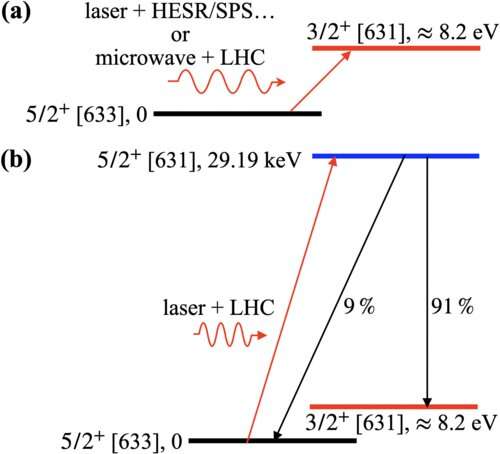This article has been reviewed according to Science X's editorial process and policies. Editors have highlighted the following attributes while ensuring the content's credibility:
fact-checked
trusted source
proofread
Thorium-229: How the first nuclear transition can be excited with lasers in the visible wavelength range

The thorium isotope with the mass number 229 (229Th) is highly exciting in many respects—for fundamental physics as well as for future applications, for example in the sense of a nuclear clock.
An international German-Chinese-American research team with the participation of Prof. Dr. Dmitry Budker's group at Johannes Gutenberg University Mainz has now proposed a completely new approach to study 229Th in detail. The researchers want to use thorium ions that have only three electrons left in their shell out of 90 present in a neutral atom.
Such a system offers many advantages, the researchers report in the current issue of the journal Physical Review Research, most notably that the first nuclear transition can be excited with conventional lasers in the visible wavelength range. This, however, requires the ions to be circulating in a relativistic storage ring.
A test laboratory for new physics
What is special about thorium-229 is that its atomic nucleus, with the metastable isomeric state thorium-229m has by far the lowest excited energy level of all the approximately 3,800 atomic nuclei currently known. It is therefore the only nuclear transition that can potentially be interrogated with lasers—even without using storage rings. The extremely precise measurement of this transition and the two nuclear states opens up promising and diverse perspectives.
To this end, the researchers led by Dmitry Budker are now proposing a new approach—both in terms of the "object of study" and the experimental setting: they are using highly charged ions, or HCIs for short, specifically those in which there are only three electrons left in the electron shell. In such highly charged thorium ions, the interplay between the electron and the nucleus opens some new transitions that can be used to "populate" the nuclear isomeric state efficiently.
The idea is to accelerate these thorium ions to almost the speed of light in a particle accelerator. In this way, they develop a leverage effect, so to speak, in order to excite them as effectively as possible with a conventional laser and thus be able to study them very precisely. Most importantly, multiple excited states can be addressed and used to "populate" the isomeric state that is actually of interest.
Most previous studies of thorium-229m have dealt with non-relativistic atoms or ions in low charge states, which places high demands on the light source required for excitation—because an extremely short-wavelength laser in the deep ultraviolet range is needed. "The fact that we can use a laser in the visible—conventional—wavelength range instead makes spectroscopic studies easier," explains Dmitry Budker.
"That this is possible at all is related to the fact that the thorium ions are accelerated to almost the speed of light. Due to relativistic effects, they perceive a laser beam directed at them from the front as a beam with a much shorter wavelength: for them, conventional laser light appears like a UV laser," adds first author Junlan Jin, currently a Ph.D. student at Princeton University, who previously worked very closely and successfully with Dmitry Budker's group as part of a remote internship.
In the current publication, the authors describe the various steps required to realize their method: They start with the generation of an accelerated beam of highly charged thorium ions, with possible accelerator rings being at the FAIR facility under construction at GSI in Darmstadt, Germany, or the planned Gamma Factory at CERN—the authors of the current thorium publication are also involved in the conceptual proposals for the realization of such a "super light source."
They then discuss in detail various scenarios for obtaining the most complete possible excitation of thorium nuclei, before focusing on the detection of the excited states produced and the transferability to similar systems.
The research team's conclusion: According to their estimate, the energy of the isomeric state can be measured with a precision better than 10-4 or even down to below 10-6, which is orders of magnitude improvement of the present value. This would pave the way for further improvements in determining the energy of the isomeric state and help answer fundamental physics questions using the thorium system.
"The development of a nuclear clock is not so much the focus of our proposal, because for its realization our new method brings various technological challenges," adds Dmitry Budker.
"For us, however, thorium is a very large 'playground' for addressing fundamental physics questions, a test lab for new physics, so to speak. For example, we want to answer the question of whether certain fundamental constants of nature are perhaps not so constant, but drift or oscillate with time or with location. In addition, one can imagine tests of fundamental symmetries and searches for particles or fields that go beyond the Standard Model."
More information: Junlan Jin et al, Excitation and probing of low-energy nuclear states at high-energy storage rings, Physical Review Research (2023). DOI: 10.1103/PhysRevResearch.5.023134
Provided by Universitaet Mainz




















